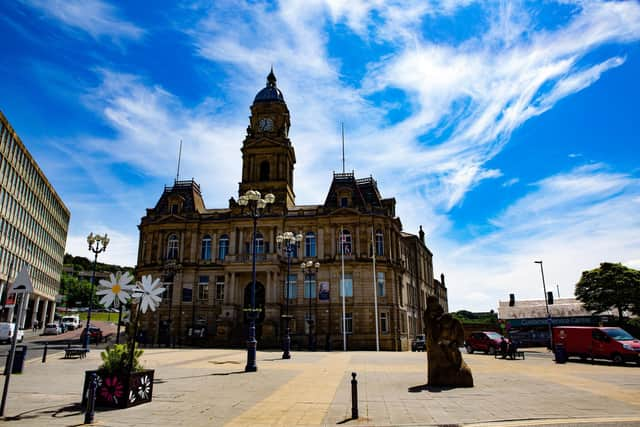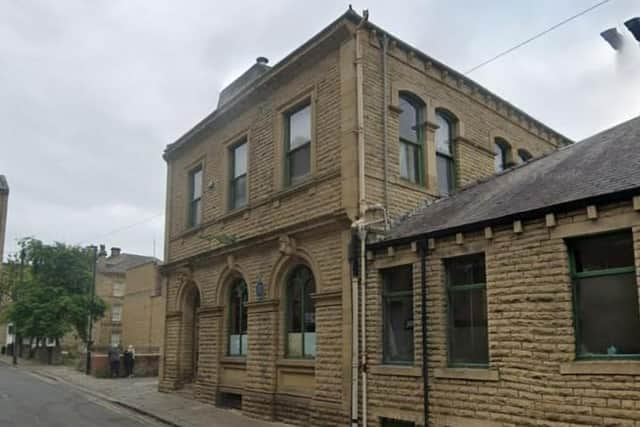From the Town Hall to the former Fox’s Auctioneers, find out which historic Dewsbury buildings have recently been listed
and live on Freeview channel 276
The new listings follow recent research carried out by Historic England, which reveal the town’s significance as an international centre for recycled cloth during the Industrial Revolution.
At the end of the 18th century Dewsbury’s population was only around 1,000, but by 1851 it had grown to more than 14,000 thanks to the rapid development of its textile industry. The town was an early adopter of mass recycling, specialising in the production of two types of yarn - known as shoddy and mungo - which were made from rags.
Advertisement
Hide AdAdvertisement
Hide AdThe trade blossomed throughout the 19th century and Dewsbury’s growing affluence was reflected in its architecture, much of which was influenced by Italian Renaissance Revival style. These include the warehouses at 18, 20 and 22 Bond Street, the former Dewsbury Union Building, as well as the block of textile warehouses on Wellington Street - all now listed at Grade II.


Also emblematic of Dewsbury’s elevated status is the opulent late Victorian Town Hall, upgraded to Grade II.
The new listings are part of the Dewsbury Heritage Action Zone, a five-year project with Kirklees Council aimed at re-energising the town centre through the restoration and reuse of its historic buildings.
Sarah Charlesworth, Listing Team Leader for the North at Historic England, said: “These newly listed buildings help to tell the story of Dewsbury’s contribution to the development of England’s textile industry and recycling.
Advertisement
Hide AdAdvertisement
Hide Ad“In the 19th century it was probably the greenest town in England!”


Here are the new listed buildings in Dewsbury:
The Town Hall – upgraded to Grade II
Built between 1886 and 1889 by well-known local architects Henry Holtom and George Arthur Fox, the Town Hall brought together a wide range of functions including municipal offices and departments, borough court, police station and event spaces.
The showpiece building symbolises the civic pride, wealth and confidence that the shoddy and mungo industry brought to the town. This was masterfully achieved with two lavishly decorated main facades and an elegant central clock tower.
Inside, the building is also opulently decorated with ornate plaster ceilings, carved stonework, stained-glass windows, and mosaic-tiled floors.
Advertisement
Hide AdAdvertisement
Hide AdKing George V and Queen Mary visited the town hall in 1912, and again in 1918, to show their appreciation for the manufacture of shoddy cloth for First World War army uniforms.
18, 20 and 22 Bond Street – listed at Grade II
These three buildings were all constructed as warehouses in Italian Renaissance style between 1862-71. 18 Bond Street was built for Crawshaw & Sons who sold leather goods and produced drive belts for machinery. 20 and 22 Bond Street were constructed for Matthew Grandidge, a wool-stapler (a dealer who buys, sorts, grades and resells wool).
Both buildings retain many original and early interior features such as ceiling beams, panelled doors and fireplaces.
These warehouses are an important reminder of Dewsbury’s textile industry in the 19th century and the peak of its prosperity and success.
Advertisement
Hide AdAdvertisement
Hide AdFormer Fox Auctioneers, 2-4 Grove Street – listed at Grade II
The former Fox’s auctioneers at 2-4 Grove Street was designed by John Kirk & Sons in 1878 for William Fredrick Fox. The site was used for the storage and sale of furniture and a range of goods, including horses.
Grove Street used to be called Fearnley Street after Dewsbury’s first mayor, Dr George Fearnley, and carved heads of both Fearnley and Fox are mounted on the front wall of number 4 Grove Street.
Luke Howgate, an undertaker, acquired the premises in 1919 and extensions were made in this year and 1933, extending number 4.
Advertisement
Hide AdAdvertisement
Hide AdThe former auction house retains many interesting features, especially those around the stabling of horses. The stable block retains stone and brick floors, gas light fittings and a small cast-iron fireplace.
Former Dewsbury Union Offices – listed at Grade II
The Former Headquarters for Dewsbury Union was constructed by an unknown architect in the 1890’s in a Renaissance Revival style. Many of the original features survive, including the mosaic flooring and an impressive cast iron staircase.
The offices were constructed on the site of the former court, police station and lockups which had earlier moved operations to the new Town Hall in 1889. It was at these offices that the Dewsbury Poor Law Union oversaw the Poor Law in the surrounding 11 parishes of Dewsbury. This number grew to 15 as four additional parishes were added in the 1890’s.
The former offices operated as a registry office for births, deaths and weddings up until 2012, when these services moved to the Dewsbury Town Hall. The building has been derelict since.
41 Daisy Hill – listed at Grade II
Advertisement
Hide AdAdvertisement
Hide Ad41 Daisy Hill was most likely built with the textile trade in mind, but its original purpose is unknown. Potentially an early piece of work by John Kirk & Sons, this building may have been designed for William Fryer, as part of a public house – Fryer’s Vaults.
Functioning as both as shop and domestic accommodation, this mid-19th century location survives well, retaining its historic shopfront.
The building remains in use as a shop and residence.
1-1a and 3 Wellington Street, 17, 21, 23 and 25, 27 and 29 Wellington Road – listed at Grade II
This collection of Wellington Street buildings all once operated as textile warehouses during Dewsbury’s position as the national centre of the shoddy and mungo industry in the latter half of the 19th century. These urban palazzo style warehouses, which have now been adapted for commercial use, are an early example of warehouses incorporating retail space in the design.
Advertisement
Hide AdAdvertisement
Hide AdThe expansion and importance of Dewsbury as a textile town was due to the development of a warehouse system which could take advantage of the railway system when it came in 1848.
This collection of former warehouses has been converted into offices and homes.
Historic England, through their Missing Pieces Project are asking people to add their own stories to Dewsbury’s listed buildings - through a new photo, a memory of visiting, or knowledge about any of the historic buildings.
For more information, visit: https://historicengland.org.uk/listing/missing-pieces/